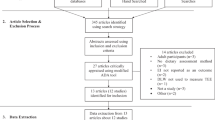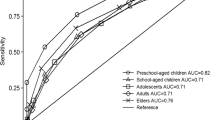Abstract
Objective: To estimate the minimum number of days of recorded dietary intake needed to place infants and young children into thirds of a population distribution with an acceptable degree of accuracy.
Design: Dietary intake data collected from 5-day weighed food records for 72 infants and young children up to 2 y of age, collected during a cross-sectional study, were analysed to estimate the number of recording days necessary to assess intake of energy and 10 nutrients.
Setting: Community study among healthy infants and children.
Subjects: Parents attended recruitment sessions in local community areas. In total, 72 subjects were entered into the study and all completed the 5-day dietary assessment period.
Interventions: A 5-day weighed record of children's dietary intake was made by the parents or regular carer.
Results: Mean within subject standard deviations were smaller than mean between subject standard deviations with respect to energy (778 vs 824 kJ/day), macronutrient subclasses: protein (8 vs 9.4 g/day); fat (9 vs 10 g/day); and carbohydrate (26 vs 29 g/day) and for specific micronutrients: calcium (163 vs 236 mg/day); phosphorus (143 vs 270 mg/day); magnesium (25 vs 43 mg/day); iron (2 vs 3 mg/day); zinc (1 vs 1.3 mg/day); ascorbic acid (27 vs 64 mg/day) and retinol equivalents (281 vs 424 μg/day). Estimated number of days of food records necessary to assess intake of energy, protein, fat and carbohydrate with acceptable degree of accuracy were 5,4,4 and 3, respectively. For all the micronutrients included in this analysis 2 days of recording were necessary.
Conclusions: Compared with adults and older children, fewer days are needed to classify this age group into thirds of the distribution with an acceptable degree of accuracy according to intake of energy and specific nutrients.
Sponsorship: The data collection phase of this study was supported by a grant from the Procter and Gamble Company, Cincinnati, OH, USA.
This is a preview of subscription content, access via your institution
Access options
Subscribe to this journal
Receive 12 print issues and online access
$259.00 per year
only $21.58 per issue
Buy this article
- Purchase on Springer Link
- Instant access to full article PDF
Prices may be subject to local taxes which are calculated during checkout
Similar content being viewed by others
References
Bingham SA (1987): The dietary assessment of individuals; methods, accuracy, new techniques and recommendations. Nutr. Abstr. Rev. 57, 705–742.
Black AE, Cole TJ, Wiles SJ & White F (1983): Daily variation in food intake of infants from 2 to 18 months. Hum. Nutr. Appl. Nutr. 37A, 448–458.
Davies PSW, Coward WA, Gregory J, White A & Mills A (1994): Total energy expenditure and energy intake in the pre-school child: a comparison. Br. J. Nutr. 72, 13–20.
Freeman JV, Cole TJ, Chinn S, Jones PRM & Preece MA (1995): Cross-sectional stature and weight reference curves for the UK, 1990. Arch. Dis. Child. 73, 17–24.
Holland B, Welch AA, Unwin ID, Buss DH, Paul AA & Southgate DAT (1991): McCance and Widdowson's The Composition of Foods, 5th Edition. London: Her Majesty's Stationery Office.
James WPT, Bingham SA & Cole TJ (1980/1981): Epidemiological assessment of dietary intake. Nutr. Cancer 2, 203–212.
Lanigan JA, Wells JCK, Lawson MS & Lucas A (2001): Validation of food diary method for assessment of dietary energy and macronutrient intake in infants and children aged 6–25 months. Eur. J. Clin. Nutr. 55, 124–129.
Marr JW & Heady JA (1986): Within- and between-person variation in dietary surveys: number of days needed to classify individuals. Hum. Nutr. Appl. Nutr. 40A, 347–364.
Mills A & Tyler H (1992): Food and Nutrient Intakes of British Infants Aged 6–12 Months. London: HMSO.
Nelson M, Black AE, Morris JA & Cole TJ (1989): Between- and within-subject variation in nutrient intake from infancy to old age: estimating the number of days required to rank dietary intakes with desired precision. Am. J. Clin. Nutr. 50, 155–167.
Paul AA, Black AE, Evans J, Cole TJ & Whitehead RG (1988): Breastmilk intake and growth in infants from two to ten months. J. Hum. Nutr. Diet. 1, 437–450.
Rao S (1987): Variation in dietary intake in adolescents. Hum. Nutr. Clin. Nutr. 41C, 71–79.
Sempos CT, Johnson NE, Smith EL & Gilligan C (1985): Effects of intraindividual and interindividual variation in repeated dietary records. Am. J. Epidemiol. 121, 120–130.
Willett WC (1990): Reproducibility and validity of food-frequency questionnaires. In Nutritional Epidemiology, pp 92–126. New York: Oxford University Press.
Acknowledgements
We are grateful to all the mothers, infants and children who took part in the study.
A previous collaborative study funded by Procter & Gamble and the British Medical Research Council provided the opportunity for this current study. Procter & Gamble has no expressed commercial interest in this study and neither the centre nor individual authors have any current financial relationship with the company.
Author information
Authors and Affiliations
Contributions
Guarantor: Professor A Lucas.
Contributors: JAL coordinated the study, conducted the field work and analysis, prepared the original manuscript and edited subsequent versions. JCW assisted with the field work and analyses; advised on and read all versions of the manuscript. MSL assisted in the original study design, participated in the field work and advised on and read all versions of the manuscript. TJC advised on appropriate statistical analyses, reviewed the analyses and read the final manuscript. AL conceived the original study and assisted in the design and appraisal of the findings.
Corresponding author
Rights and permissions
About this article
Cite this article
Lanigan, J., Wells, J., Lawson, M. et al. Number of days needed to assess energy and nutrient intake in infants and young children between 6 months and 2 years of age. Eur J Clin Nutr 58, 745–750 (2004). https://doi.org/10.1038/sj.ejcn.1601872
Received:
Revised:
Accepted:
Published:
Issue Date:
DOI: https://doi.org/10.1038/sj.ejcn.1601872
Keywords
This article is cited by
-
Relative validity of a semi-quantitative food frequency questionnaire for Singaporean toddlers aged 15–36 months
BMC Nutrition (2018)
-
Food sources of energy and nutrients in the diets of infants and toddlers in urban areas of China, based on one 24-hour dietary recall
BMC Nutrition (2015)
-
Effectiveness of a behavioural intervention to prevent excessive weight gain during infancy (The Baby Milk Trial): study protocol for a randomised controlled trial
Trials (2015)
-
Validation of a pre-coded food record for infants and young children
European Journal of Clinical Nutrition (2012)
-
Canadian infants' nutrient intakes from complementary foods during the first year of life
BMC Pediatrics (2010)



